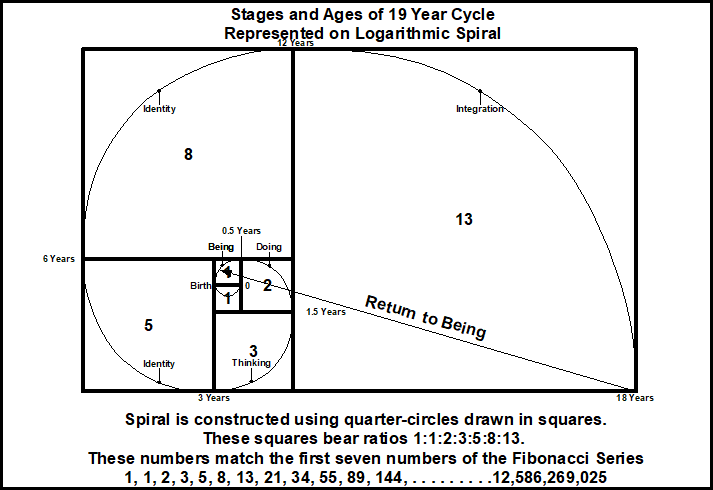Cycle of Human Development
Audio of this Blog
Audio of this Blog
We observe around us in the animal world that an offspring is left to live its life on its own around the time the mother is ready to deliver the next baby. However, that is not the case with human beings. It takes much longer. Therefore the mother, and the father too, are called upon to care for the child beyond the likely birth of the next baby. It is generally agreed that the human child grows into a self-care-taking adult by the time it has completed 18 years of age. These 18 years are spent by the growing child to clear tasks thrown by mother nature to become capable as an adult. These tasks are age specific.
Pamela Levin observed that we live our life in repeating cycles. The duration of each cycle is 19 years. Therefore we live out the same cycle five times in our life of 95 years. Each cycle of 19 years is equivalent to one calendar year. Now we have four seasons in a calendar year. Similarly in a development cycle we have six seasons. They are called Being, Doing, Thinking, Identity, Skills and Integration. These seasons are referred to as stages. The seasons in a calendar year are of equal duration of three months. However, that is not the case with stages. Being lasts for six months, doing for one year, thinking for one and half years, identity for three years, skills for six years and integration for six years. The names of stages signify the nature of tasks.
STAGE I - BEING; DURATION: Six months; From Birth to six months of age;
TASKS
Be close to, build or renew sustaining connections with others.
Take time to take things in.
Ask for help from others.
Be touched and have intimate contact.
Ask others to take over for awhile to gather strength and build energy for moving into DOING.
STAGE II - DOING; DURATION: One year; From 6 to 18 months of childhood;
TASKS
Feel, touch, see, hear, smell & taste the world.
Seek.
Feed senses while maintaining support.
Maintain BEING bonds.
Explore gravity.
STAGE III - THINKING ; DURATION: One and half year; From 18 to 36 months (3years) of childhood;
TASKS
Learning to think for ourselves.
Finding support for being independent.
Developing a separate position as an individual.
STAGE IV - IDENTITY; DURATION: Three years; From 3 to 6 years of childhood;
TASKS
Experiment with social relationships.
Test consequences.
Exert power to find out what happens.
May require taking time out from old identity to lay the groundwork for the new.
STAGE V - STRUCTURE (Skills); DURATION: Six years; From 7 to 12 years of life;
Argue, hassle & challenge.
Actively disagree with others' methods.
Make mistakes in order to find what works.
Seek people outside your usual circle of family and friends.
Develop your own ways to do things.
Try new social roles.
Experiment to find what works.
STAGE VI - REGENERATION (Integration); DURATION: Six years; from 13 to 19 years of life - teenage years;
TASKS
Develop as a sexual person.
Integrate sexual needs with needs from previous stages.
Develop personal philosophy.
Integrate sexual needs with needs from previous stages.
Develop personal philosophy.
By this stage's end we need to break out of relationships which aided our growth up to now, and reestablish them from an independent and autonomous position.
We have significant experiences concerning each of the six stages. These can be conceived as a set of ego states relevant to that age. The script development proceeds through the six stages. The script is formalised, rehearsed and installed as it were by the age of nineteen years. This script is sitting in our head. It engineers the way we live our life.
It is my considered view that the script is formally installed when we complete two cycles by our age of 38 years. We start facing challenges in our lives starting from our age of 39 years. The challenges that we face correspond to the unaccomplished tasks related to each of the six stages.
Re inserted for improving readability
----------------------
A detailed coverage of the Cycle of Development can be viewed in slides at: https://www.slideshare.net/manumjoy/cycles-of-developement-pamela-levin-transactional-analysis
Link to Pamela Levin: http://nourishingcompany.com/pam-levin-health-practitioner-and-author.htm
---------------------
Those of you who are curious to know about Fibonacci Series and Logarithmic Spiral are invited to visit this site:
http://www.crystalinks.com/fibonaccinumbers.html
The fibonacci numbers generate the golden ratio 1.6018 represented by Greek symbol Phi. Phi is one of seven universal mathematical constants. They are 0, 1, Pi, Phi, Root 2 and Root of -1 and Epsilon e. These are integrated into the geometry of the Great Pyramid.


Excellent explanation..Thank you!
ReplyDeleteWow fantastic stuff Thank you
ReplyDelete